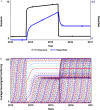Defining and Intervening on Cumulative Environmental Neurodevelopmental Risks: Introducing a Complex Systems Approach
- PMID: 33688743
- PMCID: PMC7945198
- DOI: 10.1289/EHP7333
Defining and Intervening on Cumulative Environmental Neurodevelopmental Risks: Introducing a Complex Systems Approach
Abstract
Background: The combined effects of multiple environmental toxicants and social stressor exposures are widely recognized as important public health problems contributing to health inequities. However cumulative environmental health risks and impacts have received little attention from U.S. policy makers at state and federal levels to develop comprehensive strategies to reduce these exposures, mitigate cumulative risks, and prevent harm. An area for which the inherent limitations of current approaches to cumulative environmental health risks are well illustrated is children's neurodevelopment, which exhibits dynamic complexity of multiple interdependent and causally linked factors and intergenerational effects.
Objectives: We delineate how a complex systems approach, specifically system dynamics, can address shortcomings in environmental health risk assessment regarding exposures to multiple chemical and nonchemical stressors and reshape associated public policies.
Discussion: Systems modeling assists in the goal of solving problems by improving the "mental models" we use to make decisions, including regulatory and policy decisions. In the context of disparities in children's cumulative exposure to neurodevelopmental stressors, we describe potential policy insights about the structure and behavior of the system and the types of system dynamics modeling that would be appropriate, from visual depiction (i.e., informal maps) to formal quantitative simulation models. A systems dynamics framework provides not only a language but also a set of methodological tools that can more easily operationalize existing multidisciplinary scientific evidence and conceptual frameworks on cumulative risks. Thus, we can arrive at more accurate diagnostic tools for children's' environmental health inequities that take into consideration the broader social and economic environment in which children live, grow, play, and learn. https://doi.org/10.1289/EHP7333.
Figures




Similar articles
-
Making the invisible visible: Using a qualitative system dynamics model to map disparities in cumulative environmental stressors and children's neurodevelopment.Environ Res. 2023 Mar 15;221:115295. doi: 10.1016/j.envres.2023.115295. Epub 2023 Jan 18. Environ Res. 2023. PMID: 36681143 Free PMC article.
-
Children's Environmental Health: A Systems Approach for Anticipating Impacts from Chemicals.Int J Environ Res Public Health. 2020 Nov 11;17(22):8337. doi: 10.3390/ijerph17228337. Int J Environ Res Public Health. 2020. PMID: 33187264 Free PMC article. Review.
-
The Minderoo-Monaco Commission on Plastics and Human Health.Ann Glob Health. 2023 Mar 21;89(1):23. doi: 10.5334/aogh.4056. eCollection 2023. Ann Glob Health. 2023. PMID: 36969097 Free PMC article. Review.
-
Using physiologically-based pharmacokinetic models to incorporate chemical and non-chemical stressors into cumulative risk assessment: a case study of pesticide exposures.Int J Environ Res Public Health. 2012 May;9(5):1971-83. doi: 10.3390/ijerph9051971. Epub 2012 May 22. Int J Environ Res Public Health. 2012. PMID: 22754485 Free PMC article.
-
Risk management frameworks for human health and environmental risks.J Toxicol Environ Health B Crit Rev. 2003 Nov-Dec;6(6):569-720. doi: 10.1080/10937400390208608. J Toxicol Environ Health B Crit Rev. 2003. PMID: 14698953 Review.
Cited by
-
A systematic review of the biological, social, and environmental determinants of intellectual disability in children and adolescents.Front Psychiatry. 2022 Aug 25;13:926681. doi: 10.3389/fpsyt.2022.926681. eCollection 2022. Front Psychiatry. 2022. PMID: 36090348 Free PMC article.
-
Making evidence go further: Advancing synergy between agent-based modeling and randomized control trials.Proc Natl Acad Sci U S A. 2024 May 21;121(21):e2314993121. doi: 10.1073/pnas.2314993121. Epub 2024 May 15. Proc Natl Acad Sci U S A. 2024. PMID: 38748574 Free PMC article. No abstract available.
-
Charting a Path Forward: Assessing the Science of Chemical Risk Evaluations under the Toxic Substances Control Act in the Context of Recent National Academies Recommendations.Environ Health Perspect. 2022 Feb;130(2):25003. doi: 10.1289/EHP9649. Epub 2022 Feb 23. Environ Health Perspect. 2022. PMID: 35195451 Free PMC article.
-
Mixture Math: Deciding What to Add in a Cumulative Risk Assessment.Curr Opin Toxicol. 2022 Sep;31:100358. doi: 10.1016/j.cotox.2022.100358. Epub 2022 Jun 9. Curr Opin Toxicol. 2022. PMID: 35813121 Free PMC article.
-
Making the invisible visible: Using a qualitative system dynamics model to map disparities in cumulative environmental stressors and children's neurodevelopment.Environ Res. 2023 Mar 15;221:115295. doi: 10.1016/j.envres.2023.115295. Epub 2023 Jan 18. Environ Res. 2023. PMID: 36681143 Free PMC article.
References
-
- Adamkiewicz G, Zota AR, Fabian MP, Chahine T, Julien R, Spengler JD, et al. 2011. Moving environmental justice indoors: understanding structural influences on residential exposure patterns in low-income communities. Am J Public Health 101(suppl 1):S238–S245, PMID: 21836112, 10.2105/AJPH.2011.300119. - DOI - PMC - PubMed
-
- Alaimo K, Olson CM, Frongillo EA Jr.. 2001. Food insufficiency and American school-aged children’s cognitive, academic, and psychosocial development. Pediatrics 108(1):44–53, PMID: 11433053. - PubMed
-
- Allen JL, Liu X, Pelkowski S, Palmer B, Conrad K, Oberdörster G, et al. 2014a. Early postnatal exposure to ultrafine particulate matter air pollution: persistent ventriculomegaly, neurochemical disruption, and glial activation preferentially in male mice. Environ Health Perspect 122(9):939–945, PMID: 24901756, 10.1289/ehp.1307984. - DOI - PMC - PubMed
-
- Allen JL, Liu X, Weston D, Prince L, Oberdörster G, Finkelstein JN, et al. 2014b. Developmental exposure to concentrated ambient ultrafine particulate matter air pollution in mice results in persistent and sex-dependent behavioral neurotoxicity and glial activation. Toxicol Sci 140(1):160–178, PMID: 24690596, 10.1093/toxsci/kfu059. - DOI - PMC - PubMed
Publication types
MeSH terms
Grants and funding
LinkOut - more resources
Full Text Sources
Other Literature Sources
Medical

